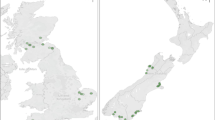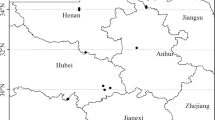Abstract
The enemy release hypothesis (ERH) outlines the most widely tested and accepted invasion mechanism. Within the ERH there are two hypotheses, the evolution of increased competitive ability hypothesis (EICA) and the shift in defence hypothesis (SDH), which describe how this mechanism may work. To our knowledge these two hypotheses are yet to be comprehensively tested in a single study. Therefore, the aim of this study was to test them for three Acacia species (A. cyclops, A. longifolia and A. saligna) that have become highly invasive in their introduced ranges. We grew these species in a controlled glasshouse experiment from seed collected from multiple populations in their native and introduced ranges in Australia. We then measured their growth (proxy for competitive ability) as well as their qualitative (terpenes) and quantitative (phenolics) defences. We found that A. longifolia plants grown from introduced range seed produced more biomass (marginally non-significant) and terpenes and less phenolics than their native range counterparts, providing strong evidence for the SDH. In contrast, there was no difference in growth or chemical defences for A. cyclops and A. saligna between ranges. This may be because these two species were introduced to eastern Australia ~ 50 years prior to A. longifolia being introduced to western Australia, giving more chance for natural enemies to adapt to them in their introduced range. If this is true, we can conclude that A. longifolia currently poses the greatest invasion risk of our Acacia study species and therefore warrants the closest management attention.


Similar content being viewed by others
References
Agosta S, Klemens J (2008) Ecological fitting by phenotypically flexible genotypes: implications for species associations, community assembly and evolution. Ecol Lett 11:1123–1134
Ainsworth EA, Gillespie KM (2007) Estimation of total phenolic content and other oxidation substrates in plant tissues using Folin–Ciocalteu reagent. Nat Protoc 2:875–877
Atlas of Living Australia website. http://www.ala.org.au. Accessed 19 Aug 2018
Bazzaz FA, Chiariello NR, Coley PD, Pitelka LF (1987) Allocating resources to reproduction and defense. Bioscience 37:58–67
Birnbaum C, Leishman MR (2013) Plant-soil feedbacks do not explain invasion success of Acacia species in introduced range populations in Australia. Biol Invasions 15:2609–2625
Birnbaum C, Barrett LG, Thrall PH, Leishman MR (2012) Mutualisms are not constraining cross-continental invasion success of Acacia species within Australia. Divers Distrib 18:962–976
Blossey B, Notzold R (1995) Evolution of increased competitive ability in invasive nonindigenous plants: a hypothesis. J Ecol 83:887–889
Callaway RM, Ridenour WM (2004) Novel weapons: invasive success and the evolution of increased competitive ability. Front Ecol Environ 2:436–443
Clemens J, Jones PG, Gilbert NH (1977) Effect of seed treatments on germination in Acacia. Aust J Bot 25:269–276
Colautti RI, Maron JL, Barrett SCH (2009) Common garden comparisons of native and introduced plant populations: latitudinal clines can obscure evolutionary inferences. Evol Appl 2:187–199
Correia M, Castro S, Rodriguez-Echeverria S (2015) Reproductive success of Acacia longifolia (Fabaceae, Mimosoideae) in native and invasive populations. Aust J Bot 65:387–391
Correia M, Montesinos D, French K, Rodriguez-Echeverria S, Mack R (2016) Evidence for enemy release and increased seed production and size for two invasive Australian acacias. J Ecol 104:1391–1399
Crous CJ, Burgess TI, Le Roux JJ, Richardson DM, Slippers B, Wingfield MJ (2016) Ecological disequilibrium drives insect pest and pathogen accumulation in non-native trees. AoB Plants. https://doi.org/10.1093/aobpla/plw081
Doorduin LJ, Vrieling K (2011) A review of the phytochemical support for the shifting defence hypothesis. Phytochem Rev 10:99–106
Feeny P (1976) Plant apparency and chemical defense. In: Wallace JW, Mansell RL (eds) Biochemical interaction between plants and insects: recent advances in phytochemistry. Springer, Boston
Felker-Quinn E, Schweitzer JA, Bailey JK (2013) Meta-analysis reveals evolution in invasive plant species but little support for evolution of increased competitive ability (EICA). Ecol Evol 3:739–751
Hanley ME, Girling RD, Felix AE, Olliff ED, Newland PL, Poppy GM (2013) Olfactory selection of Plantago lanceolata by snails declines with seedling age. Ann Bot 112:671–676
Harris CJ, Dormontt EE, Le Roux JJ, Lowe A, Leishman MR (2014) No consistent association between changes in genetic diversity and adaptive responses of Australian acacias in novel ranges. Evol Ecol 26:1345–1360
Harris CJ, Manea A, Moles A, Murray B, Leishman MR (2016) Differences in life-cycle stage components between native and introduced ranges of five woody Fabaceae species. Austral Ecol 42:404–413
Harvey K, Nipperess D, Britton D, Hughes L (2013) Does time since introduction influence enemy release of an invasive weed? Oecologia 173:493–506
Hawkes CV (2007) Are invaders moving targets? The generality and persistence of advantages in size, reproduction, and enemy release in invasive plant species with time since introduction. Am Nat 170:832–843
Herms D, Mattson W (1992) The dilemma of plants: to grow or defend. Q Rev Biol 67:283–335
Huang W, Siemann E, Wheeler GS, Zou J, Carrillo J, Ding J (2010) Resource allocation to defence and growth are driven by different responses to generalist and specialist herbivory in an invasive plant. J Ecol 98:1157–1167
Inderjit (2012) Exotic plant invasion in the context of plant defense against herbivores. Plant Physiol 158:1107–1114
Janzen DH (1985) On ecological fitting. Oikos 45:308–310
Joshi S, Gruntman M, Bilton M, Seifan M, Tielbarger K (2013) A comprehensive test of evolutionarily increased competitive ability in a highly invasive plant species. Ann Bot 114:1761–1768
Keane RM, Crawley MJ (2002) Exotic plant invasions and the enemy release hypothesis. Trends Ecol Evol 17:164–170
Lau JA, Schultheis EHC (2015) When two invasion hypotheses are better than one. New Phytol 205:958–960
Leishman MR, Wright I, Moles A, Westoby M (2000) The evolutionary ecology of seed size. In: Fenner M (ed) Seeds: the ecology of regeneration in plant communities. CABI Publishing, Southampton, pp 31–57
Lorenzo P, Pazos-Malvidoa E, Gonzalez L (2010) Differential responses to allelopathic compounds released by the invasive Acacia dealbata Link (Mimosaceae) indicate stimulation of its own seed. Aust J Bot 58:546–553
Lorenzo P, Pereira CS, Rodriguez-Echeverria S (2013) Differential impact on soil microbes of allelopathic compounds released by the invasive Acacia dealbata Link. Soil Biol Biochem 57:156–163
Low PA, McArthur C, Fisher K, Hochuli DF (2014) Elevated volatile concentrations in high-nutrient plants: do insect herbivores pay a high price for good food? Ecological Entomology 39:480–491
Mitchell C, Blumenthal D, Jarosik V, Puckett E, Pyšek P (2010) Controls on pathogen species richness in plants’ introduced and native ranges: roles of residence time, range size and host traits. Ecol Lett 13:1525–1535
Muller-Scharer H, Schaffner U, Steinger T (2004) Evolution in invasive plants: implications for biological control. Trends Ecol Evol 19:417–422
Pimentel D, Zuniga R, Morrison D (2005) Update on the environmental and economic costs associated with alien-invasive species in the United States. Ecol Econ 52:273–288
Preston FW (1960) Time and space and the variation of species. Ecology 41:611–627
R Development Core Team (2016) R: a language and environment for statistical computing. R Foundation for Statistical Computing, Vienna
Rehman F, Khan FA, Badruddin SMA (2012) Role of phenolics in plant defense against insect herbivory. In: Khemani LD, Srivastava MM, Srivastava S (eds) Chemistry of phytopotentials: health, energy and environmental perspectives. Springer, Berlin Heidelberg, pp 309–313
Rejmánek M, Richardson DM (2013) Trees and shrubs as invasive alien species-2013 update of the global database. Divers Distrib 19:1093–1094
Rhoades D, Cates R (1976) Toward a general theory of plant antiherbivore chemistry. Recent Adv Phytochem 10:168–213
Richardson DM, Rejmánek M (2011) Trees and shrubs as invasive alien species—a global review. Divers Distrib 17:788–809
Rosenkranz M, Schnitzler J (2016) Plant volatiles. eLS. Wiley, Chichester
Siemann E, Rogers WE, Dewalt SJ (2006) Rapid adaptation of insect herbivores to an invasive plant. Proc R Soc B Biol Sci 273:2763–2769
Stutz RS, Banks PB, Proschogo N, McArthur C (2016) Follow your nose: leaf odour as an important foraging cue for mammalian herbivores. Oecologia 182:643–651
Trinder CJ, Brooker RW, Robinson D (2013) Plant ecology’s guilty little secret: understanding the dynamics of plant competition. Funct Ecol 27:918–929
Uesugi A, Kessler A (2013) Herbivore exclusion drives the evolution of plant competitiveness via increased allelopathy. New Phytol 198:916–924
van Kleunen M, Schmid B (2003) No evidence for an evolutionary increased competitive ability in an invasive plant. Ecology 84:2816–2823
Vilà M, Gómez A, Maron J (2003) Are alien plants more competitive than their native conspecifics? A test using Hypericum perforatum L. Oecologia 137:211–215
Vilà M, Basnou C, Pyšek P, Josefsson M, Genovesi P, Gollasch S, Nentwig W, Olenin S, Roques A, Roy D, Hulme PE (2009) How well do we understand the impacts of alien species on ecosystem services? A pan-European, cross-taxa assessment. Front Ecol Environ 8:135–144
Wilson JRU, Gairifo C, Gibson MR, Arianoutsou M, Bakar BB, Baret S, Celesti-Grapow L, DiTomaso JM, Dufour-Dror JM, Kueffer C, Kull CA, Hoffmann JH, Impson FAC, Loope LL, Marchante E, Marchante H, Moore JL, Murphy DJ, Tassin J, Witt A, Zenni RD, Richardson DM (2011) Risk assessment, eradication, and biological control: global efforts to limit Australian acacia invasions. Divers Distrib 17:1030–1046
Zheng Y-L, Feng Y-L, Zhang L-K, Callaway RM, Valiente-Banuet A, Luo D-Q, Liao Z-Y, Lei Y-B, Barclay GF, Silva-Pereyra CC (2015) Integrating novel chemical weapons and evolutionarily increased competitive ability in success of a tropical invader. New Phytol 205:1350–1359
Acknowledgements
We thank Dr. Christina Birnbaum and Dr. Carla Harris for seed collection, Dr. Soo Jean Park for her assistance with the GCMS, Dr. Ian Jamie for allowing us to use his GCMS and Dr. Muhammad Masood for assistance with the Plant Growth Facility at Macquarie University. This project was funded by a Macquarie University Research Fellowship awarded to Alexandra Carthey.
Author information
Authors and Affiliations
Corresponding author
Additional information
Publisher's Note
Springer Nature remains neutral with regard to jurisdictional claims in published maps and institutional affiliations.
Rights and permissions
About this article
Cite this article
Manea, A., Tabassum, S., Carthey, A.J.R. et al. Evidence for a shift in defence driving the invasion success of Acacia longifolia in Australia. Biol Invasions 21, 2211–2220 (2019). https://doi.org/10.1007/s10530-019-01968-0
Received:
Accepted:
Published:
Issue Date:
DOI: https://doi.org/10.1007/s10530-019-01968-0




